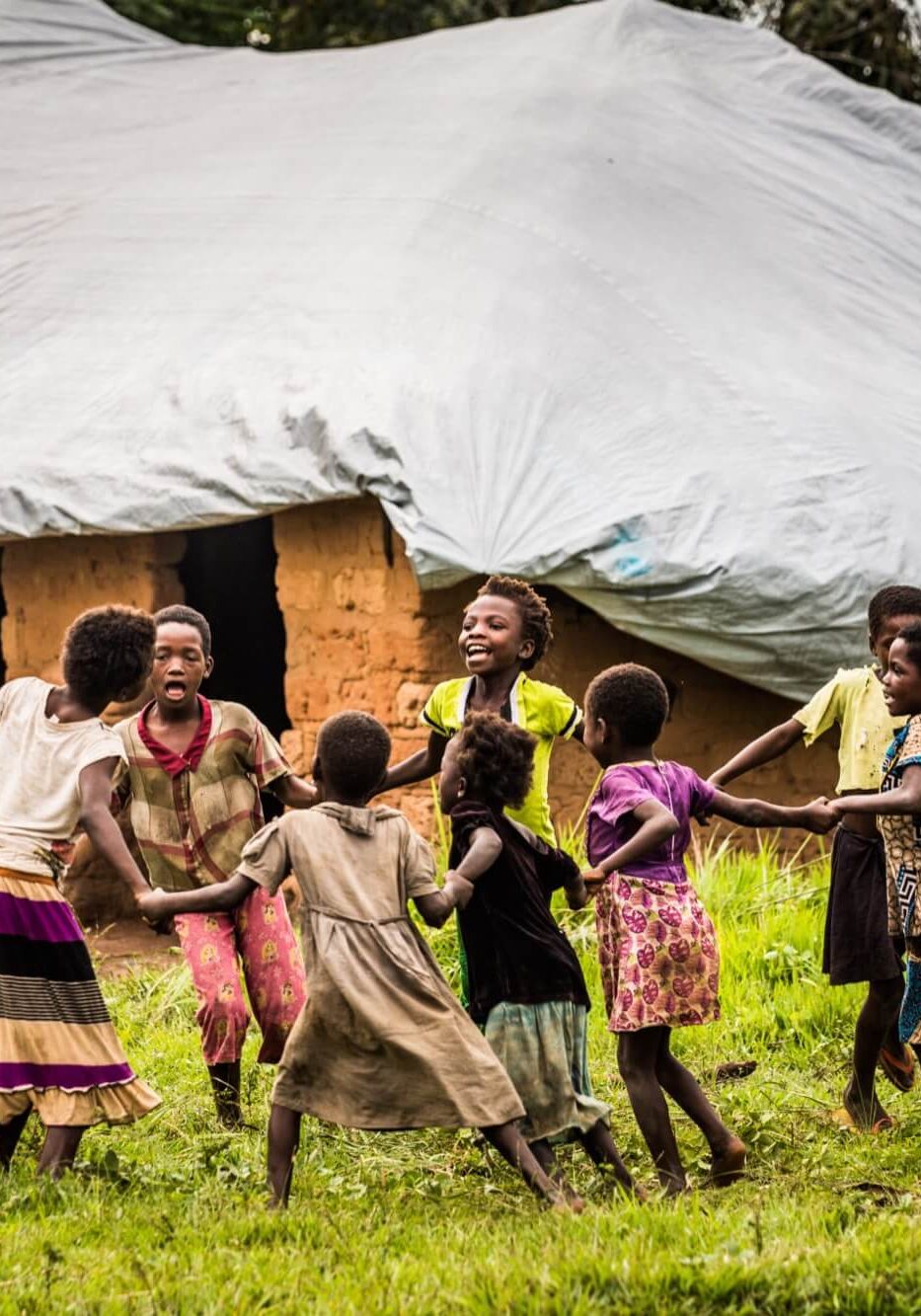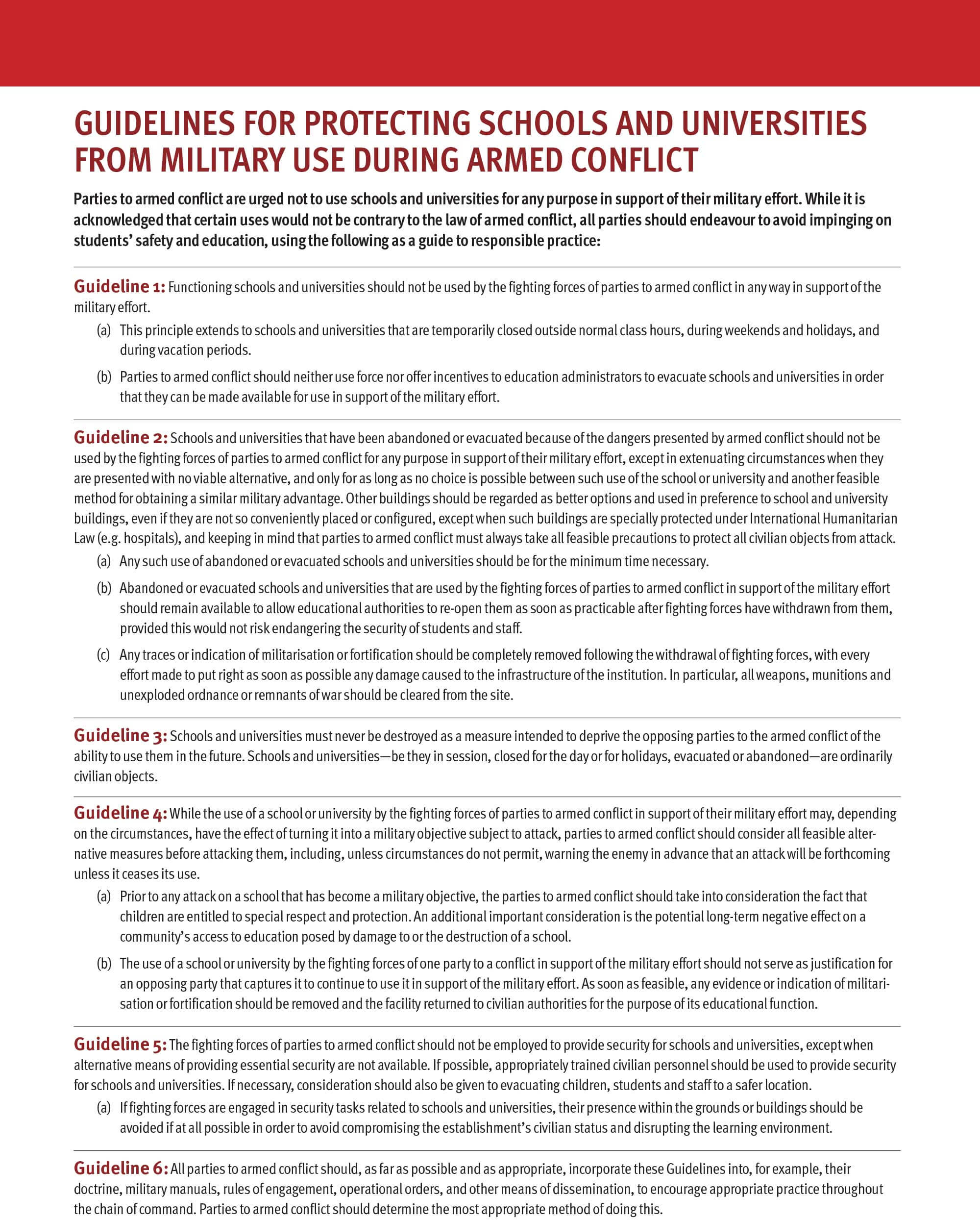The Safe Schools Declaration
An inter-governmental political commitment to protect students, teachers, schools, and universities from the worst effects of armed conflict
Every boy and girl has the right to an education without fear of violence or attack.
Every teacher, professor, and school administrator should be able to teach and research in conditions of safety, security, and dignity.
Every school should be a protected space for students to learn, and fulfil their potential, even during war.
Every university should be a safe place for students and academics and to foster critical and independent thinking, and to harness knowledge.
“I love school a lot because through my studies, I’ll have a better future. I’ll be able to support my family and look after myself. I want to be a doctor.”
Tshiela, aged 10, a student from Mulombela village, Kasai region, Democratic Republic of Congo, whose school was attacked by government forces in 2017.

Children play outside a temporary school set up by UNICEF during a mid-day break, near Mbuji Mayi, Kasai region, on January 27, 2018. © UNICEF/Tremeau, 2018
The Safe Schools Declaration
In 2015, the governments of Norway and Argentina led a process among United Nations (UN) Member States to develop the Safe Schools Declaration, an inter-governmental political agreement dedicated to protecting education in armed conflict.
The Safe Schools Declaration outlines a set of commitments to strengthen the protection of education from attack and restrict use of schools and universities for military purposes. It seeks to ensure the continuity of safe education during armed conflict. The Declaration was opened for countries to endorse at the First International Conference on Safe Schools in Oslo, Norway, in May 2015.
In March 2017, the government of the Argentine Republic hosted the Second International Conference on Safe Schools, further building upon the development of a global community dedicated to protecting education in armed conflict. In May 2019, the government of Spain hosted the Third International Conference on Safe Schools in Palma de Mallorca, and in October 2021, the government of Nigeria hosted the Fourth International Conference on the Safe Schools Declaration in Abuja.
To date, 122 states around the world have joined this international political agreement.
Support for the Safe Schools Declaration has come from the highest levels within the UN, notably from UN Secretary-General António Guterres; former High Commissioner for Human Rights, Zeid Ra’ad Al Hussein; and Special Representative for Children and Armed Conflict, Virginia Gamba - each of whom has urged all UN Member States to endorse the Declaration.
The Declaration builds a community of nations committed to respecting the civilian nature of schools and developing and sharing examples of good practices for protecting schools and universities during armed conflict. It offers guidance on concrete measures that armed forces and armed non-state actors can take to deter military use of educational facilities, to reduce the risk of attack, and to mitigate the impact of attacks and military use when they do occur.
Countries also commit to collect, or facilitate the collection of, data on attacks on education; investigate and prosecute war crimes involving education; and provide assistance to victims.
By endorsing the Declaration, States also commit to restoring access to safe education and to developing education systems that are conflict-sensitive and promote respect between social or ethnic groups.
The Safe Schools Declaration is a framework for collaboration and exchange, and endorsing countries meet on a regular basis to review implementation of the Declaration.
The Commitments
By endorsing the Declaration, countries commit to undertake the following steps to protect students, teachers, schools, and universities from attack and military use:
Implement the Guidelines for Protecting Schools and Universities from Military Use during Armed Conflict, and bring them into domestic policy and operational frameworks as far as possible and appropriate;
Collect reliable data on attacks and military use of schools and universities, including through existing monitoring and reporting mechanisms;
Provide assistance to victims of attacks, in a non-discriminatory manner;
Investigate allegations of violations of national and international law and prosecute perpetrators where appropriate;
Develop and promote “conflict-sensitive” approaches to education;
Seek to continue safe education during armed conflict and restore access to safe education after attacks;
Support the UN’s work on the children and armed conflict agenda; and
Meet on a regular basis, inviting relevant international organizations and civil society, to review implementation of the Declaration and use of the Guidelines.
International, regional, and national organizations can play a key role in supporting governments to implement these commitments.
The Fifth International Conference on the Safe Schools Declaration, November 25th-26th, 2025. Safe Education for All: A Decade of Commitment, a Call to Action through the Safe Schools Declaration
The Fifth International Conference on the Safe Schools Declaration took place in Nairobi, Kenya from 25-26 November, 2025. Hosted by the Government of Kenya, in partnership with the Governments of Argentina, Norway and Spain, the Global Coalition to Protect Education from Attack (GCPEA), UNICEF, UNESCO, Plan International and Save the Children, the conference brought together governments, UN agencies, civil society, academia, children, and youth advocates. It served as a platform to reflect on progress, share experiences, and adopt the Nairobi Outcome Document to lay the way forward for the protection of education from attack. For more on the 5th International Conference, read GCPEA's Daily Snapshots here.
The Guidelines for Protecting Schools and Universities from Military Use During Armed Conflict
The Guidelines for Protecting Schools and Universities from Military Use during Armed Conflict were developed to provide clear and simple guidance for armed actors. They are a non-binding practical tool that aims to help parties to conflict – both government armed forces and armed non-state actors – to exercise restraint with respect to the use of schools and universities for military purposes.
Military use of educational infrastructure risks converting schools and universities into military objectives, exposing students and teachers to the potentially devastating consequences of attack. Military use can be prevented by making changes to legislation, doctrine, military orders, rules of engagement, practice, and training.
The Guidelines are based on what is practically achievable. They acknowledge that parties to armed conflict are invariably faced with difficult dilemmas requiring pragmatic solutions.
The Guidelines encourage a change in mentality and shift in behavior regarding the military use of schools and universities, through integration into military policies and doctrine, and application of good practice.
Support for the Declaration at International and Regional Level
United Nations Secretary General, António Guterres, urged all Member States to endorse the Safe Schools Declaration in his 2017 report to the United Nations Security Council on protection of civilians in armed conflict. The Secretary General repeated this recommendation in his 2018 annual report on children and armed conflict.
The Special Representative of the Secretary General on Children and Armed Conflict, Virginia Gamba, first called for endorsement of the Declaration in her 2017 annual report to the General Assembly. At the May 2018 launch of Education under Attack 2018, she renewed her call, and encouraged every Member States that has not already done so, to endorse the Safe Schools Declaration and to begin work at once to make it operational.”
The UN Department of Peace Operations included the Declaration and Guidelines as a reference under international norms and standards on children’s rights in their new Child Protection Policy, released in June 2017. UN peacekeepers are already required not to use schools in line with the DPO ban on the practice.
Since August 2016, the Peace and Security Council of the African Union has repeatedly encouraged all its Member States to sign the Safe Schools Declaration.
The European Commission’s Education in Emergencies policy communication, the Commission states that it “recognizes and supports the work of the Global Coalition to Protect Education from Attack and will support initiatives to promote and roll out the Safe Schools Declaration.”
Since August 2016, the Peace and Security Council of the African Union has repeatedly encouraged all its Member States to sign the Safe Schools Declaration.
In December 2018, the International Committee of the Red Cross and Red Crescent published its position on the Declaration and Guidelines. A key aspect of their position is the recognition that avoiding situations where education facilities become military objectives, and therefore liable to attack, goes a long way in ensuring the safety of civilians – students and education personnel – and in preserving the civilian character of schools and their corresponding protection from attack, so that they can continue to safely operate during armed conflict.
As part of its Strategy on Access to Education, the ICRC provides “support for enhanced implementation of the Guidelines at the level of states affected by conflict and violence”. The ICRC stands ready to offer its legal reading of the Guidelines and to provide technical advice to all interested parties regarding how to best implement them in specific contexts, regardless of whether they have already endorsed the Safe Schools Declaration or are simply considering it.
SIGN UP FOR UPDATES
Sign up for regular updates on endorsement and implementation of the Safe Schools Declaration

